The iPhone 7 and iPhone 7 Plus Review: Iterating on a Flagship
by Joshua Ho & Brandon Chester on October 10, 2016 8:00 AM EST- Posted in
- Smartphones
- Apple
- Mobile
- iOS
- iOS 10
- iPhone 7
- iPhone 7 Plus
Battery Life
As-is, one of the most important factors for upgrading a smartphone remains battery life, due to a combination of inherent demand for a phone that can last 2-3 days of use and applications that demand enormous amounts of performance over long periods of time. Apps like WeChat are fairly notorious for holding wakelocks on Android and never really stopping background resource usage so there’s also an element of OS optimization that goes with keeping real-world in battery life up to expectations.
In order to test these things, we’ve spent the past year developing and validating a new web browsing battery life test which updates the sites used and introduces a scrolling component which attempts to better model how a number of tasks are not simply race to sleep and contain a steady-state component. We’ve also updated our rundown tests to better reflect reality and maintain appropriate loads as some devices with high-end SoCs and low display resolution were outpacing our testing. As always, all displays are set to 200 nits with location and other background services disabled to reach a useful relative comparison.

Looking at our WiFi web browsing test, it’s genuinely ridiculous how well the iPhone 7 and 7 Plus perform in this test. The iPhone 7 Plus is definitely down on battery life compared to the Galaxy S7 Edge, but it’s within 5% despite using a battery that’s almost 20% smaller. The iPhone 7 is actually comparable in battery life to the iPhone 7 Plus, and is significantly above the Galaxy S7 with Exynos 8890. Of course, the iPhone 7 has a significantly lower resolution display and a smaller battery, but the nature of smartphone design is that larger devices will generally have better battery life because the board area needed remains mostly constant while the amount of area for battery increases. The iPhone 7 has significantly improved in battery life here, likely due to a combination of A10 Fusion's power optimizations – particularly the small CPU cores – and the removal of the headphone jack, which teardown photos show to have been partially replaced with the battery. However if you do the math efficiency sees a relatively minor uplift.
One other interesting point is that Brandon accidentally ran the battery test on his iPhone 7 with a Safari Content Blocker enabled, which blocked all the ads on the sites that the test visits. In doing so, battery life rose from the normal result of 9.22 hours to 10.03 hours, demonstrating how the increased workload and long-running network requests from ads and trackers really impacts a smartphone's battery life. It's also worth noting that our test constantly cycles through pages, so if you spend a lot of time on a single page with ads you could see an even greater difference.
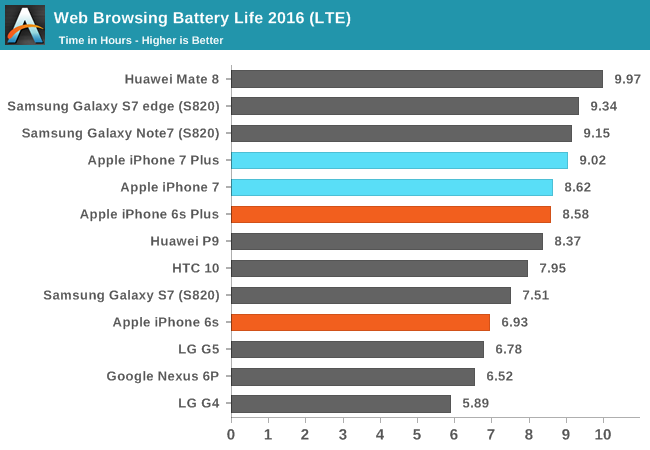
Moving on to LTE battery life the iPhone 7 and 7 Plus both slip a bit, but remain impressive. I suspect that the 20nm Qualcomm modem here is not well-equipped to handle the endless stream of ads that is increasingly a part of most websites. As ads tend to stream in incredibly slowly, the standby power of the modem is a significant factor. Snapdragon 820 devices don’t see nearly the impact here that the iPhone 7 and 7 Plus as their modem is on 14LPP rather than 20SoC. The iPhone 7 remains above the S820 Galaxy S7, but the iPhone 7 Plus is fairly comparable to the iPhone 6s Plus in battery life on LTE.

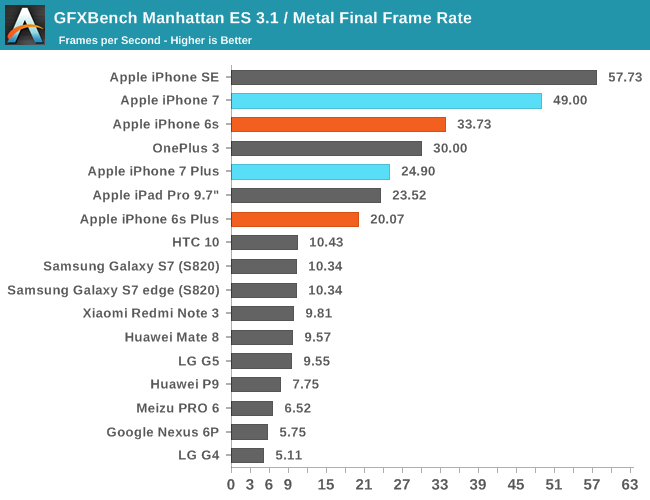
Moving past the web browsing test we use we can take a look at how the iPhone 7 Plus throttles. Unfortunately Basemark OS II was basically broken in this regard for the CPU rundown test so we can only look at how it behaves on Manhattan 3.1, but it's interesting to see how the GPU performance drops about 40% for the iPhone 7 Plus while the iPhone 7 throttles around 20%, because even Manhattan 3.1 is pegged to vsync which means that the GPU can spend much more time idling once a given frame is rendered. It's probably not a surprise here but the iPhone 7 just doesn't last very long here because battery life is strongly SoC-bound. If you attempted to plot battery life as a function of overall SoC utilization, it's entirely possible that the iPhone 7 might last longer than the 7 Plus at the lower bound for utilization, but as soon as you go past web browsing and similarly "light" tasks the 7 Plus and most phablets are going to strongly outperform such a small phone. Here the larger battery helps to get the iPhone 7 Plus nearly another hour of battery life when the SoC is under full, continuous load.
Charge Time
As usual, while battery life is the salient characteristic that determines overall mobility, it’s important to not ignore charge time as there are a number of edge cases where charging has a significant impact on overall mobility. In order to test this we use power measurements at the wall and measure the time it takes from the moment that the charger is plugged in to the moment that it falls below a pre-determined draw from the wall. While this isn’t perfect due to varying levels of DC conversion efficiency and different methods of trickle charging, this method provides at least a reasonable approximation of how long it will take to charge a device.
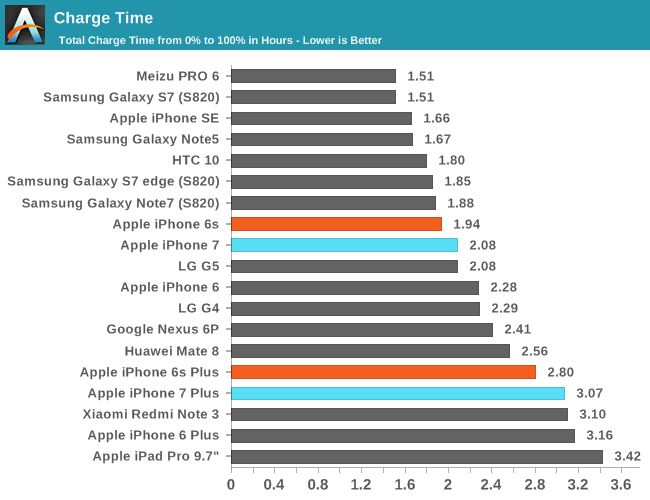
In the case of the iPhone 7 and 7 Plus, Apple continues to ship their standard 5W chargers for US variants. Looking at the results, it’s probably obvious that at least in the case of the iPhone 7 Plus, there is a very real need for Apple to start shipping something with faster charging, as the standard 5W charger takes a full hour longer than most of its competition to charge to 100%. Even the iPhone 7 could use a higher power charger here as using the device while it is charging will significantly impact the charging rate as the charger cannot supply enough power to the board while also charging the battery. And in the case of both phones, the lack of a high power charger doesn't just draw out the total charge time, but it also precludes rapid charging (partially charging a depleted phone very quickly) as well.
It would really be prudent for Apple to start to transitioning to higher power AC adapters at this point. This doesn’t take away from how impressive battery life is, but overall mobility isn’t going to be better than the competition unless you go out of your way to buy an iPad charger.


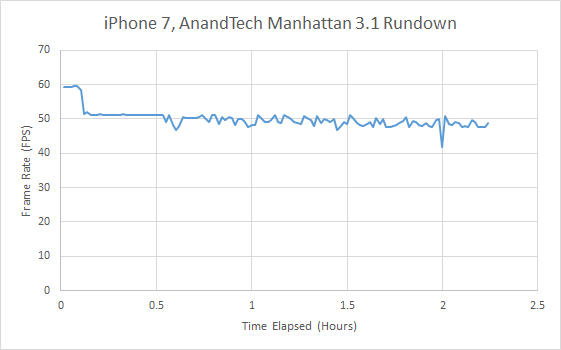
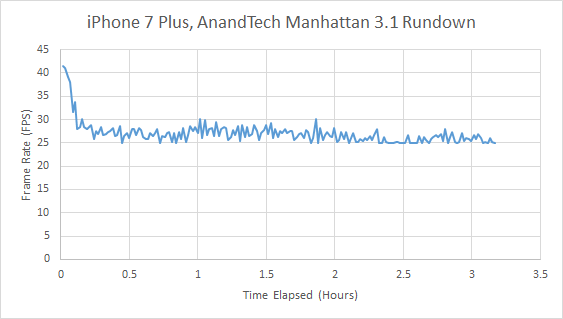
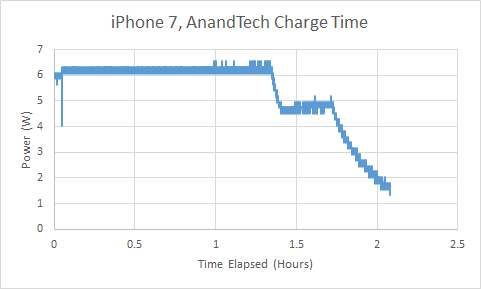
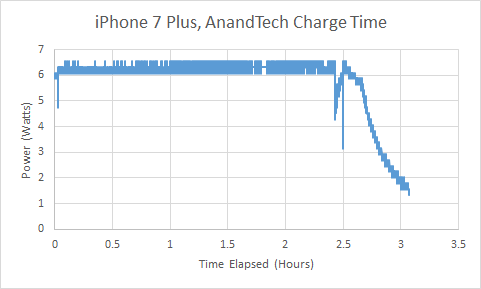








377 Comments
View All Comments
lolipopman - Tuesday, October 11, 2016 - link
I agree that Apple rules the market currently.*Currently*. It actually seems that the recently announced ARM A73 will be a beast.
And let's not forget the Mali G71 which is said to be very close to Nvidia Shield's performance.
I'm curious what the A11 chip will be bringing to the graphics table when the next revision of iPhones drop.
jospoortvliet - Tuesday, October 11, 2016 - link
Sadly the A73 won't even make a dent, it is maybe 20% faster at same power, that isn't a third of the gap with Apple...GPUs are doing better indeed but with far higher pixel densities end user experience is still that much worse.
tuxRoller - Tuesday, October 11, 2016 - link
Unfortunately it won't. The a73 looks to be quite good at efficiency, but per clock perf is still going to be decently far behind.As for graphics, no one can match IMG for efficiency. I really wish arm/Softbank would buy IMG.
ex2bot - Wednesday, October 12, 2016 - link
Android has been competitive in many areas and just plain better in some important ones (customization, screen quality, flexibility, choice), but the truth is that Qualcomm fell behind in perf with the 810 and 820. It looks like the 821 is close in performance.Secondly, the 7 and 7 Plus are most likely going to show better battery life because they have bigger batteries than the 6s and 6S Plus.
CloudWiz - Thursday, October 13, 2016 - link
821 is just a clocked-bumped 820, the performance difference between 820 and 821 will be less than 10%. Kryo is currently twice as slow as Hurricane in ST and far less efficient.cknobman - Monday, October 10, 2016 - link
I'm just going to reference this: http://www.windowscentral.com/best-smartphone-came...This was a blind test of over 13000 people voting on pictures taken in many many different scenarios. It compared 4 of the top smartphone cameras (which one of which was the iPhone 7).
The Galaxy S7 won by a landslide, not even close.
The iPhone 7 has its own drawbacks largely ignored by this review.
The lack of a headphone jack is a bigger issue that anyone makes it out to be and iOS is a terribly hindered OS that makes using any iPhone an painful experience.
Sure the battery life is good/great but this is largely because Apple choosing to remain so far back in their resolution. If you live in a Apple box and only look at their devices then sure its fine.
But go use any of the dozens of non Apple phones out there and then come back to an iPhone (especially the plus) and you immediately notice the lowered resolution and display quality.
The Garden Variety - Monday, October 10, 2016 - link
I was in tears and the injustice of this "review" until I read your supportive, nurturing reply. Thank you for giving all of us hope. Hope that the truth will reign, and that someday tech "journalists" will be exposed and jailed for their obvious bias. JAILED.cknobman - Monday, October 10, 2016 - link
LOL Your butthurt was so painful it seems you could not even comprehend what I wrote.I never called out the reviewer for bias or injustice but you apparently only choose to read/see/envision what you want...............either that or you are just plain stupid.
grayson_carr - Monday, October 10, 2016 - link
Let me propose a scenario. You have two identical displays. One is perfectly calibrated. One has the color saturation boosted and does not display colors accurately. If you pull a bunch of people off the street and have them look at both displays and vote on which one looks better, which one do you think they are going to pick? Answer: They are going to say the one with boosted saturation is better despite it being an identical display with objectively worse calibration. The average person does not know what is good, which is why I think blind photo comparisons are stupid. Now I'm not saying the Galaxy S7 doesn't have the best camera in a phone. The Galaxy S7 probably does have the best camera in a phone (in stills at least, video sucks). But I would much rather hear it from a professional photographer than a bunch of average Joes that know nothing about photography or cameras. That's just me.menting - Monday, October 10, 2016 - link
a professional photographer will probably feel insulted to even consider a rating a photo from a phone.